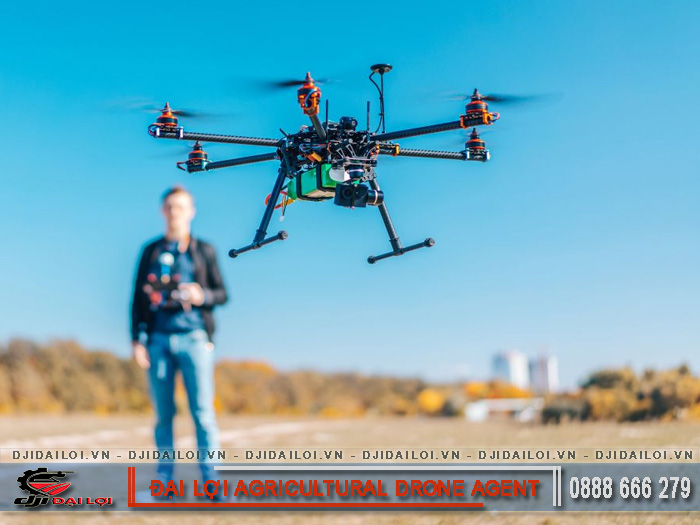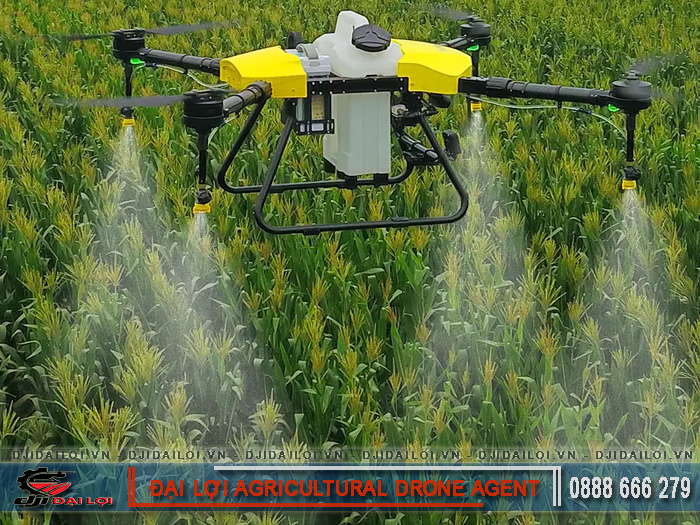
A flycam is a type of unmanned aerial vehicle (UAV) remotely operated, mainly used for filming, photography, and aerial monitoring. In agriculture, it helps farmers observe crop conditions, detect pests, and monitor cultivation progress without being physically present in the field.
Unlike specialized drones, flycams focus on flexibility, easy operation, and visual observation rather than heavy-duty tasks like spraying or seeding. They are valuable tools that enhance farm management and support faster decision-making in modern agricultural production.
A drone is an unmanned aerial vehicle capable of operating autonomously or semi-autonomously, programmed to perform specific tasks such as pesticide spraying, seed distribution, fertilizing, or terrain surveying.
In agriculture, drones use RTK sensors, multispectral cameras, and high-precision GPS systems to optimize farming processes. Through automation, drones help reduce labor costs, save chemicals, and increase crop yields. Drones are now a central technology of smart farming in Vietnam and worldwide.
Both flycams and drones belong to the unmanned aerial vehicle category, powered by electric motors and remote controllers. They both capture aerial data for crop monitoring, mapping, and farm management.
However, flycam and drones differ in their intended purpose: flycams are designed for visual observation, while drones focus on automation and production efficiency. Their shared strength lies in advancing digital agriculture and helping farmers manage large-scale operations more effectively.
|
Criteria |
Flycam |
Drone |
|---|---|---|
|
Design purpose |
Filming, photography, monitoring |
Spraying, seeding, surveying |
|
Body structure |
Lightweight, compact, easy takeoff |
Large, sturdy, heavy-duty |
|
Control system |
Manual via remote controller |
Automated via GPS or RTK programming |
|
Maximum weight |
0.5–2 kg |
10–50 kg depending on model |
|
Extra functions |
Video recording, livestream |
Spraying, terrain mapping, NDVI imaging |
→ The table shows that flycam and drones differ fundamentally in design and functionality, reflecting their intended use and operating capabilities.
Flycams usually carry only lightweight cameras, whereas drones can mount chemical tanks, sensors, or heavy equipment. Drones are equipped with multiple propellers and balancing sensors for stability in strong winds or uneven terrain.
This explains why drones are preferred for large-scale farming, while flycams are better suited for observation and small-scale research.
Flycams prioritize image resolution and transmission quality, making them ideal for filming and visual monitoring. Agricultural drones, although with lower camera resolution, integrate range sensors, obstacle avoidance radar, and terrain sensors for more accurate flight paths.
→ This means flycam and drones differ not only in hardware but also in the type of data they collect.
Standard flycams use basic GPS, with an error margin of 0.5–1 meter, suitable for filming. Agricultural drones, however, use RTK (Real-Time Kinematic) technology, enabling centimeter-level accuracy-crucial for spraying or seeding tasks.
RTK technology gives drones a significant advantage in precision agriculture.
Agricultural drones have longer battery life (20–40 minutes per flight) due to high-capacity batteries, while flycams usually operate for 10–20 minutes. Flycams, however, recharge faster and are more flexible.
In terms of efficiency and field coverage, drones outperform, handling 10–20 hectares per day, while flycams are limited to monitoring.
Flycams capture aerial images, helping farmers identify flooded zones, pest infestations, or nutrient deficiencies. The recorded data supports production reports, crop promotion, and progress tracking.
Due to their affordability and ease of use, flycams are ideal tools for smallholders, especially in organic or eco-tourism farming models.
Modern agricultural drones like DJI Agras T50 or T40 can spray pesticides, distribute seeds, and create 3D terrain maps with high precision. RTK sensors and radar systems allow autonomous flight, obstacle avoidance, and automatic spray rate adjustments.
→ This advancement optimizes labor productivity, reduces costs, and protects farmers’ health.
If the main goal is monitoring, filming, or quick visual assessment, flycams are the better choice due to lower costs and simpler maintenance. Large-scale farms, on the other hand, need specialized drones for spraying, seeding, or surveying.
Selecting the right device helps maximize investment and productivity, especially as flycam and drones differ significantly in capability and functionality.
|
Category |
Consumer flycam |
Agricultural drone |
|---|---|---|
|
Typical 2025 price |
10–40 million VND |
120–450 million VND |
|
Main manufacturers |
DJI, Autel, Hubsan |
DJI Agras, XAG, Aifield |
|
Included accessories |
Battery, charger, camera |
Tank, RTK base, radar |
|
User group |
Individuals, small farms |
Cooperatives, large farms |
|
Purpose |
Filming, monitoring |
Spraying, seeding, surveying |
→ Flycam and drones differ greatly in cost due to disparities in structure, payload, and control technology. Agricultural drones require RTK systems, radar sensors, and high-power controllers, making them far more expensive but also more profitable if used effectively.
Operating costs directly affect the investment efficiency of aerial devices. On average, agricultural drone batteries last 150–200 charge cycles and need replacing every 1–2 years at 8–15 million VND each, while flycam batteries cost only 1–3 million VND.
Drones also require maintenance for nozzles, RTK sensors, radar, and high-pressure spray motors, with annual upkeep accounting for 5–10% of total value. Flycams mainly need camera cleaning and software updates.
→ Clearly, flycam and drones differ significantly in long-term investment and maintenance requirements.
Although drones are more expensive, their return on investment (ROI) is higher due to improved labor efficiency. A single agricultural drone can replace 4–6 workers per day, spray accurately, and reduce pesticide use by 20–30%.
Most drones can pay for themselves in just 2–3 growing seasons, while flycams provide visual benefits but limited direct income. Thus, drones suit commercial-scale farming, whereas flycams remain valuable analytical tools.

To operate unmanned aerial vehicles in Vietnam, users must apply for permission from the Ministry of National Defense at least 14 days before flying, as per Decree No. 36/2008/NĐ-CP. The application includes:
Restricted areas include military zones, airports, borders, strategic sites, and dense residential areas. Unauthorized flights may result in fines of 40–80 million VND or device confiscation.
Understanding how flycam and drones differ is crucial not only technically but also for legal compliance.
In Vietnam, personal flycams can be used for recreation or tourism but still require registration when flying in public spaces. Commercial drones, especially agricultural ones, face stricter management due to heavier payloads and higher altitudes.
Recent regulations require businesses to register device IDs and operator information and follow national air safety standards.
This distinction emphasizes that flycam and drones differ not only in function but also in legal responsibility.
Operators must keep at least 30 meters away from people and animals and avoid flying in strong winds, rain, or storms.
Before flight, check battery level, propellers, sensors, and GPS/RTK signals. Avoid flying near power lines or populated areas.
Accidents causing property damage, fires, or chemical pollution can result in civil liability. Adhering to regulations ensures safe, efficient operations, especially as flycam and drones differ in flight range and purpose.
To choose between flycam and drones, users should consider:
Identifying actual needs ensures investment efficiency, especially since flycam and drones differ in features, costs, and benefits.
Leading flycam brands like DJI are ideal for individuals and smallholders.
For agricultural drones, models such as DJI Agras T25P, T40, T50, T70P, and T100 dominate due to durability, precision spraying, and strong after-sales service.
Users should choose devices with available spare parts and local maintenance support for long-term reliability.
Small farms should start with monitoring flycams to learn flight skills and gather field data. As they scale up, adopting RTK-enabled agricultural drones increases productivity.
Businesses should plan 3–5 years ahead, covering training, maintenance, and software upgrades.
Strategic investment helps optimize capital and competitiveness, especially as flycam and drones differ clearly in technology and application value.
In summary, flycam and drones differ in vision and action-flycams help you observe, drones help you perform. Understanding each type’s strengths and investment costs enables farmers to optimize resources, boost productivity, and step confidently into smart farming.
Yes. A flycam is essentially a consumer-grade drone used for filming and monitoring, with simpler structure and lighter payload than agricultural drones.
No. Although drones can spray, seed, and map, flycams remain vital for visual monitoring and quick small-area inspections.
Yes. For beginners, a flycam helps practice flight skills, navigation, and data collection-an ideal step before operating professional drones.
Yes. Operating agricultural drones requires trained pilots knowledgeable in flight safety and advanced RTK or autonomous flight systems.
Yes. Personal flycams usually only need registration for public flights, while commercial drones must obtain flight permits and report activity areas to the Ministry of National Defense.